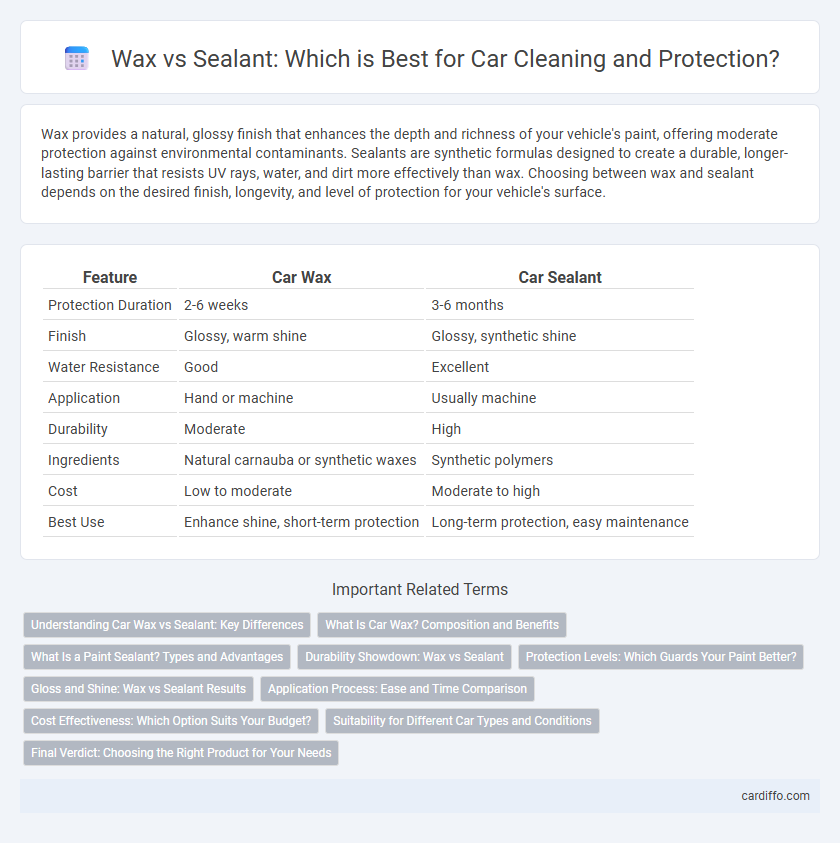Wax provides a natural, glossy finish that enhances the depth and richness of your vehicle's paint, offering moderate protection against environmental contaminants. Sealants are synthetic formulas designed to create a durable, longer-lasting barrier that resists UV rays, water, and dirt more effectively than wax. Choosing between wax and sealant depends on the desired finish, longevity, and level of protection for your vehicle's surface.
Table of Comparison
| Feature | Car Wax | Car Sealant |
|---|---|---|
| Protection Duration | 2-6 weeks | 3-6 months |
| Finish | Glossy, warm shine | Glossy, synthetic shine |
| Water Resistance | Good | Excellent |
| Application | Hand or machine | Usually machine |
| Durability | Moderate | High |
| Ingredients | Natural carnauba or synthetic waxes | Synthetic polymers |
| Cost | Low to moderate | Moderate to high |
| Best Use | Enhance shine, short-term protection | Long-term protection, easy maintenance |
Understanding Car Wax vs Sealant: Key Differences
Car wax provides a natural, glossy finish and enhances paint depth using natural oils and beeswax, while sealants are synthetic polymers offering longer-lasting protection against environmental contaminants. Sealants typically last between 4 to 6 months, providing a durable barrier against UV rays, dirt, and water, whereas wax usually lasts 4 to 6 weeks and requires more frequent application. Choosing between wax and sealant depends on the desired finish, longevity, and maintenance frequency for optimal vehicle paint protection.
What Is Car Wax? Composition and Benefits
Car wax is a protective substance primarily composed of natural or synthetic waxes, such as carnauba or silicone-based compounds, designed to create a glossy, hydrophobic layer on the vehicle's paint. This layer enhances shine, repels water, and provides a moderate level of protection against UV rays, dirt, and minor contaminants. Wax improves the car's aesthetic appeal while offering a temporary barrier that requires regular reapplication to maintain effectiveness.
What Is a Paint Sealant? Types and Advantages
A paint sealant is a synthetic protective coating designed to shield automotive paint from environmental contaminants, UV rays, and oxidation. Common types include polymer-based sealants and ceramic sealants, each offering durability ranging from six months to two years. Sealants provide a glossy finish and long-lasting protection, outperforming traditional wax in terms of longevity and resistance to harsh weather.
Durability Showdown: Wax vs Sealant
Sealants offer superior durability, typically lasting 4-6 months compared to wax's 2-4 weeks, providing extended protection against environmental contaminants and UV damage. Synthetic polymers in sealants form a robust, long-lasting barrier that resists water, dirt, and oxidation more effectively than natural carnauba wax. For those prioritizing long-term paint preservation and reduced maintenance frequency, sealants present a more resilient solution in the durability showdown.
Protection Levels: Which Guards Your Paint Better?
Wax offers a natural, glossy finish with moderate protection against UV rays and contaminants, typically lasting 2-4 weeks. Sealant provides a synthetic barrier that lasts significantly longer, often 4-6 months, delivering superior resistance to oxidation, chemicals, and water spots. For optimal paint protection, sealants guard better due to their durability and stronger bonding properties.
Gloss and Shine: Wax vs Sealant Results
Car wax provides a deep, warm gloss with a natural shine that enhances the paint's richness, while sealants offer a more reflective and durable shine that lasts longer under harsh conditions. Wax typically produces a softer, more vibrant glow due to its natural oils and carnauba components, whereas sealants deliver a sleek, glass-like finish by forming a protective synthetic barrier. For optimal gloss and shine results, waxes excel in immediate visual impact, but sealants maintain their brilliance over extended periods with superior resistance to environmental factors.
Application Process: Ease and Time Comparison
Wax typically requires a more involved application process, including multiple layers and longer curing times, which can take up to 30-45 minutes per section. Sealants are generally easier and faster to apply, often needing only a single thin layer that cures in 15-20 minutes, making them ideal for quicker detailing sessions. The ease of sealant application helps save time while still providing durable protection compared to the more labor-intensive waxing process.
Cost Effectiveness: Which Option Suits Your Budget?
Wax offers an affordable initial cost, making it a budget-friendly choice for car enthusiasts seeking short-term shine and protection. Sealants, while pricier upfront, provide longer-lasting durability and reduce the frequency of applications, resulting in lower maintenance expenses over time. Evaluating your budget alongside desired protection duration helps determine whether wax or sealant delivers better cost-effectiveness for your vehicle care needs.
Suitability for Different Car Types and Conditions
Wax enhances the deep, rich shine best suited for older, classic cars with cured, oxidized paint, while sealants provide longer-lasting protection ideal for modern vehicles with clear coats. Sealants form a durable synthetic barrier that repels contaminants and UV rays, making them preferable for cars exposed to harsh weather or frequent washing. For vintage cars with delicate finishes, wax offers a more natural, flexible coating that breathes with the paint, preserving its integrity over time.
Final Verdict: Choosing the Right Product for Your Needs
Wax provides a deep, natural shine and enhances paint depth, ideal for show cars and short-term protection, while sealants offer longer-lasting durability and superior resistance against environmental contaminants, making them suitable for daily drivers. Selecting between wax and sealant depends on your priority: choose wax for aesthetic appeal and ease of application, or opt for sealant for extended protection and less frequent maintenance. Assess vehicle usage, climate conditions, and desired finish to determine the most effective product for your specific cleaning and protection needs.
Wax vs Sealant Infographic

 cardiffo.com
cardiffo.com